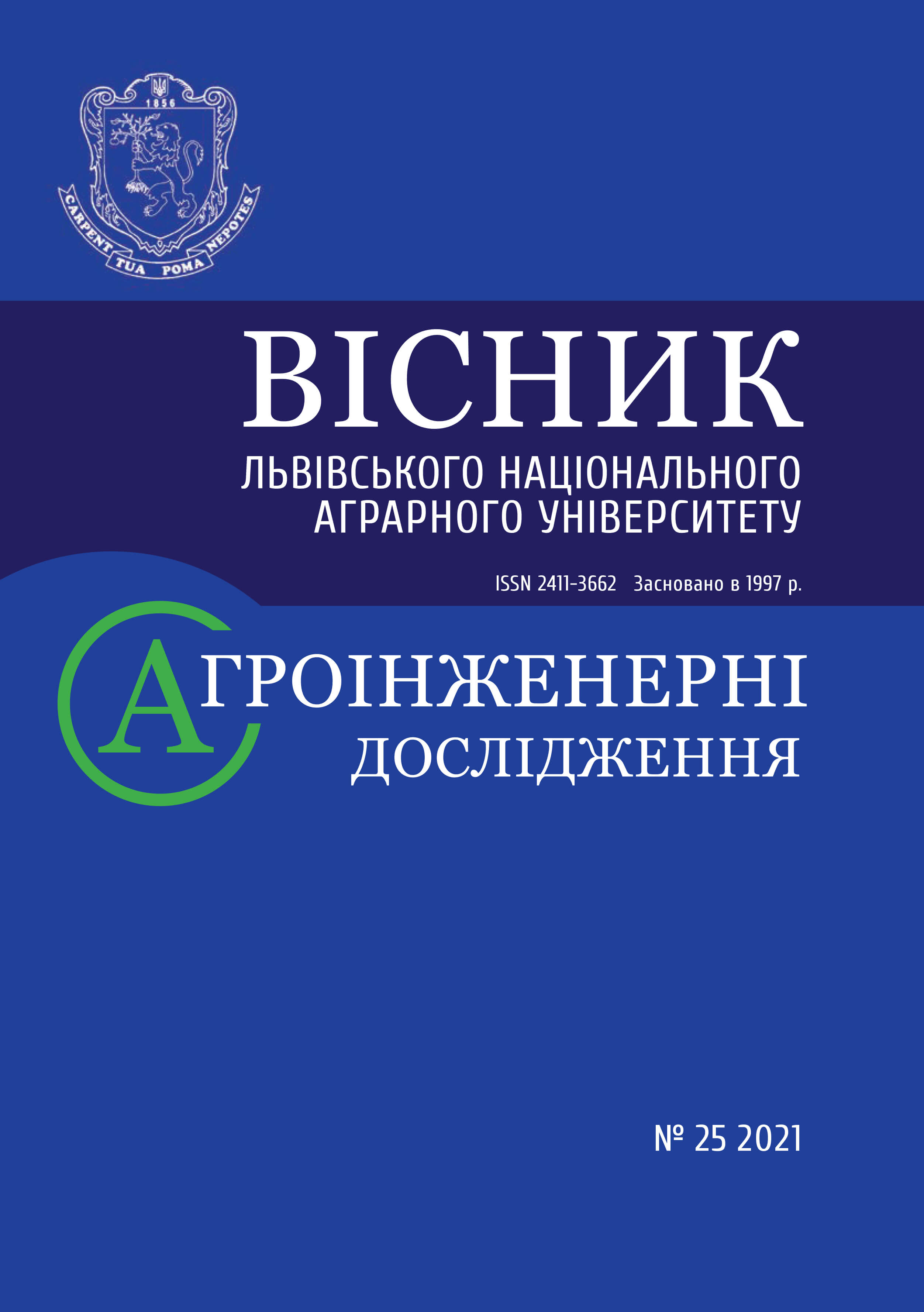Study of the efficiency of a pneumatic separator with an inclined channel on the preparation of safflor seed material
DOI:
https://doi.org/10.31734/agroengineering2021.25.028Keywords:
safflower seeds, seed material, sorting, fullness of seeds, pneumatic separator, field researchAbstract
Safflower is an oil seed. Safflower was imported to Ukraine in the second half of the 18th century. It was mainly grown in small areas of the southern arid regions.
The article presents the results of the study of impact of the safflower seed fullness on its yield. A seed mixture of safflower of Lahidnyi variety was taken as the initial material for the study. The mateeial was grown in the experimental field of KhNTUSG in 2020. The initial mixture included 92.7 % of safflower seeds, 5.14 % of light impurities, 0.43 % of seeds of other cultivated plants, 1.42 % of weed seeds and 0.31 % of mineral impurities. The germination energy of the seeds of the main crop was 61.73% and its germination was 65.24 %. Sorting was performed on a pneumatic separator with an inclined channel. After purification on a separator, four fractions were obtained.
The best filled seeds were sorted to the first fraction and accounted for 38.52 % by weight of the source material, 22.46 % was sorted to the second fraction, 16.53 % - to the third, and 22.49 % - to the fourth one.
The field research was conducted in 2021 in the educational and research field of the Department of Agrotechnology and Ecology on the basis of SRF "Central" of Kharkiv Petro Vasylenko National Technical University of Agriculture. The repetition was double, the placement of plots was randomized. The area of the experimental plot was 25 m2. It was preceeded by black fallow.
The growth, development and productivity of safflower were studied in the field experiment.
In general, the best plants were obtained from seeds that were sorted to the first fraction. Thus, the number of baskets was by 35.85 % more than the baskets of plants obtained from seeds of the second fraction and by 140 % as compared to the plants of the third fraction. The size of the baskets and the number of seeds from one plant of the first fraction were also the largest and acoounted for 3.1 mm and 117.7 pcs respectively. Seeds obtained from plants of the first fraction were the fullest and the weight of 1000 seeds was 47 g.
Seeds of the second fraction provided quite worthy indicators of safflower production. Seeds of the third and especially the fourth fraction were more expedient to be used for other purposes.
References
Bakum, M. V., Krekot, M. M., Abduiev, M. M., & Maiboroda, M. M. (2019). Rezultaty vyrobnychykh vyprobuvan pnevmatychnoho separatora na dodatkovomu sortuvanni nasinnia horokhu. Visnyk KhNTUSH im. P. Vasylenka, 198, 74–77. [in Ukrainian].
Bakum, M. V., Krekot, M. M., Mykhailov, A. D., Kozii, A. B., Maiboroda, M. M., Puzik, V. K. … Tsyba, M. V. (2019). Obhruntuvannia efektyvnosti vykorystannia reshitnykh separatoriv dlia pidhotovky posivnoho materialu safloru. Visnyk KhNTUSH im. P. Vasylenka, 198, 18–25. [in Ukrainian].
Bakum, M. V., Mykhailov, A. D., Kozii, O. B., Chalaia, O. S., Beliaiev, V. V., Nykonenko, V. V., & Syvoplias, R. Yu. (2019). Doochyshchennia ta sortuvannia nasinnia safloru na vibrofryktsiinomu separatori. Visnyk KhNTUSH im. P. Vasylenka, 198, 12–17. [in Ukrainian].
Didora, V. H., Smahlii, O. F., Ermantraut, E. R., Hudz, V. P., Moiseienko, V. V., Manko, Yu. P. … Khrapiichuk, P. P. (2013). Metodyka naukovykh doslidzhen v ahronomii. Kyiv: Tsentr navch. lit. [in Ukrainian].
Dryncha, V. M. (2006). Yssledovanye separatsyy semian y razrabotka mashynnykh tekhnolohyi ykh pidhotovky. Voronezh: NPO “Modek”. [in Russian].
Elnaz Ebrahimian, Seyyed Mohammad Seyyedi, Ahmad Bybordi, & Christos A. Damalas. (2019). Seed yield and oil quality of sunflower, safflower, and sesame under different levels of irrigation water availability. Agricultural Water Management, 218(1), 149–157. doi: 10.1016/j.agwat.2019.03.031.
Filipov, Ye. H. (2014). Ahrotekhnichni pryiomy na ekonomichnu efektyvnist vyroshchuvannia safloru krasylnoho v umovakh zroshennia pivdnia Ukrainy. Visnyk ahrarnoi nauky Prychornomoria, 2, 143–149. [in Ukrainian].
Kharchenko, S. O. (2017). Aprobatsiia rozroblenykh reshit z aktyvatoramy u vyrobnychykh umovakh. Materialy naukovo-praktychnoi konferentsii vykladachiv, aspirantiv ta studentiv (Vol. 3, p. 68). Sumy: NAU. [in Ukrainian].
Kharchenko, S. O. (2018). Teoriia protsesiv prosiiuvannia zernovykh sumishei na vibroreshetakh zernoochysnykh mashyn. Tsili staloho rozvytku tretoho tysiacholittia: Materialy Mizhnar. nauk.-prakt. konf. (Vol. 5, pp. 249–253). Kyiv: NUBiP. [in Ukrainian].
Kharchenko, S., Kovalishin, S., Zavgorodniy, A., Kharchenko, F., & Mikhaylov, Y. (2018). Intensification of sifting of flat grain on sieves of grain-cleaning machines. Agicultural Engineering, 3, 56, 39–56.
Overview of the Oilseed Safflower (Carthamus tinctorius L.) (2016). In Encyclopedia of Food Grains (Second Edition) (Vol. 1, pp. 254–258). North Dakota State University. doi: 10.1016/B978-0-12-394437-5.00030-9.
Rozhkov, A. O., Puzik, V. K., Kalenska, S. M., Puzik, L. M., Popov, S. I., Muzafarov, N. M. … Kryshtop, Ye. A., & Rozhkov, A. O. (Ed.). (2016). Doslidna sprava v ahronomii. (Kn. 2). Kharkiv: Maidan. [in Ukrainian].
Shahrokhnia, M. H., & Sepaskhah, A. R. (2017). Physiologic and agronomic traits in safflower under various irrigation strategies, planting methods and nitrogen fertilization. Industrial Crops and Products, 95, 126–139. doi: 10.1016/j.indcrop.2016.10.021.
Sukhbir Singh, Sangamesh V. Angadi, Kulbhushan K. Grover, Rolston St. Hilaire, & Sultan Begna. (2016). Effect of growth stage based irrigation on soil water extraction and water use efficiency of spring safflower cultivars. Agricultural Water Management, 177, 432–439. doi: 10.1016/j.agwat.2016.08.023.
Ushkarenko, V. O., & Lazer, P. N. (ed.) (2012). Vyroshchuvannia safloru na Pivdni Ukrainy. Kherson: PP «LT-Ofis». [in Ukrainian].
Zaika, P. M. (2006). Teoriia silskohospodarskykh mashyn. (Vol. 3). Kharkiv: Oko. [in Ukrainian].


